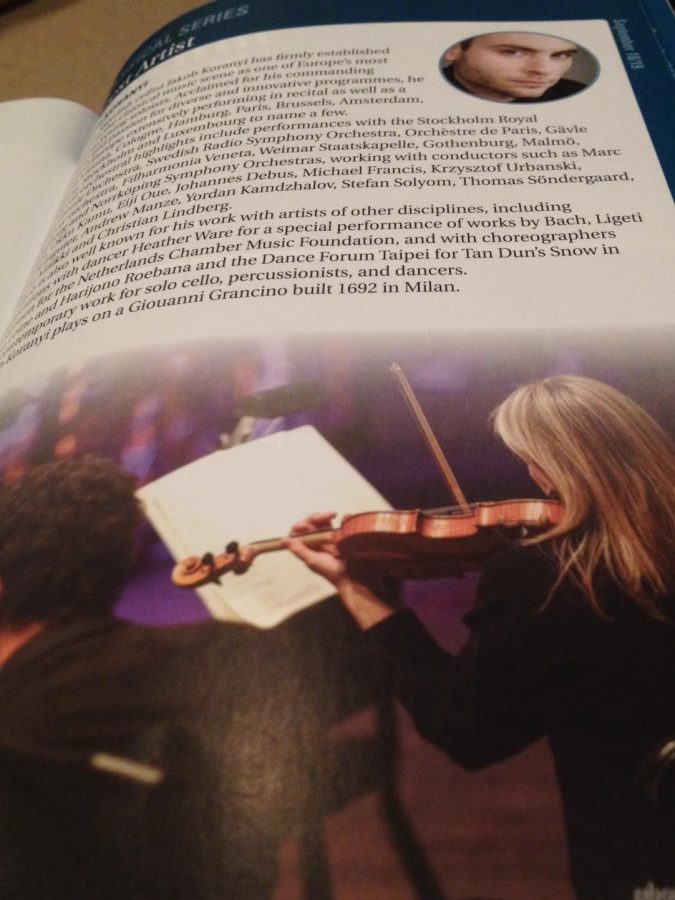Grand Rapids Symphony Provides Surprisingly Entertaining Evening
Symphony concerts are not entirely new to me. I have early memories of attending several Detroit Symphony Orchestra concerts as a kid, squirming in my seat and counting down the minutes until the music stopped and I could leave to go do something that was actually fun. Despite the years I spent playing in school orchestras, I’ve remained skeptical about orchestral concerts ever since. I usually find them excruciatingly boring and mercilessly long. As a general rule, I don’t enjoy going to the symphony.
I’m not quite sure why I decided to attend the Grand Rapids Symphony’s “Romeo and Juliet” concert this past Saturday with the rest of my family, but nevertheless, I did. I entered DeVos Performance Hall highly skeptical that I would enjoy the performance. I sat down in Row B, seat 7 of the mezzanine and steeled myself for an hour and a half of boredom. To my surprise, that is not at all what I experienced.
As 8:00 approached, I flipped through the program apathetically. Once I found the information about that evening’s performance amidst page after page of colorful, glossy advertisements, I happily noticed that each of the three pieces the symphony would play that night had a run time listed in the program. I instinctively began making comparisons between cross country workouts and the song durations.
First up was Hector Berlioz’s Overture to Beatrice and Benedict: eight minutes. I could handle that: just an easy mile-long jog.
Next was Camille Saint-Saens’s Concerto for Cello and Orchestra No. 1 in A Minor: nineteen minutes. Ouch. That was more like an all-out 5k race. That would be difficult.
Wrapping up the evening’s program was Prokofiev’s Suite from Romeo and Juliet: a whopping 35 minutes long. No running comparison came to mind, but, I thought, the suite was undoubtedly comparable to some kind of long and painful interval workout. As the lights dimmed and the quiet pre-concert hum of voices and instruments fell to silence, I seriously questioned why I had come at all.
As the light, energetic opening notes of the Berlioz piece reached my ears, I immediately took note of the simple fact that these symphony musicians were actually talented. After years of elementary and middle school orchestra concerts, I had almost forgotten that the sound of an orchestra that plays totally in tune and totally together can actually be quite pleasant. As the musicians nimbly moved from quick, punchy vignettes to longer, more flowing sections of slow grace and back to the fast energy of the opening, I found that the eight minutes were not at all painful. While I wouldn’t go so far as to say that I enjoyed them, I was not too crushed by boredom to be unimpressed by the sound of a group of musicians who are extremely skilled at what they do.
The crowd applauded after the first song, and a few moments later, the Swedish cello soloist for the Saint-Saens piece entered the stage to another round of applause. I silently thanked the Symphony for providing something other than the black-clad mass of instrumentalists to look at. Going to the symphony is definitely not a source of visual entertainment: there’s not much to look at unless you can find a musician who gets really into the music (and there were several on stage that night, ducking and weaving and jerking their heads in time with their entrances and crescendos) to silently amuse yourself with. The soloist broke up the monotony that may otherwise have set in with this second, more lengthy piece and kept my mind from drifting away from the music and into thoughts such as what time the concert would be over.
By the time the lights came back on for intermission, I was shocked that, thus far, the concert had not been a repeat of my childhood visits to the Detroit Symphony. The fact that I was halfway through the performance and not yet bored was astounding to me. I made my way to the lobby amongst a crowd of fancily-dressed adults and reveled in the sheer sophistication of my current situation. If nothing else, going to the symphony is a way to instantly make yourself feel more cultured and refined than you actually are.
After being blocked from the stairs for a few minutes by a surprise reenactment of the balcony scene from Romeo and Juliet in the lobby by two professional actors who both could have used better microphones, I returned to my seat and prepared for the true endurance test: the 35-minute Prokofiev suite. The program promised that I would be able “hear the fierce rivalry between the two families” in the music. I highly doubted that, as I’ve never found classical music to be particularly moving, but after the first half of the concert I was willing to give them a try at it.
The piece was begun, closed, and filled from minute one to minute thirty-five with drama. I was stunned that I actually enjoyed listening to it. Aside from some inopportune banging noises caused by fireworks at a festival across the street, the symphony’s performance was fantastic. The piece came to a close and was met with an explosion of applause and a standing ovation, in which I heartily took part.
My experience at the symphony was not life-changing by any means, but it certainly surpassed my expectations. Was I emotionally affected by the music at that night’s concert? Not really. Did the performances make me a devotee of classical music? No. But did I enjoy sitting in that seat for 62 minutes and listening to the music? Surprisingly, I did.
Take this as a challenge: next time you have a free Saturday night, consider spending it at the symphony instead of on the couch. A night at the symphony is most definitely not a night of Netflix, or a night at a football game, or a night hanging out with friends. It requires patience, focus, open-mindedness, and a willingness to embrace the unfamiliar. It’s an exercise in the expansion of the mind. It may not be the most fun you’ll ever have, but your mind will one day thank you. And, if you’re lucky, you might even enjoy the music.

Ally is entering her second year on staff and is an Editor in Chief this year. Ally served as the Copy Editor for the Central Trend last year and enjoyed...

























































































